(Adding an image of GP2 outside the Beer Tent!) |
(1950) Tag: Visual edit |
||
| (9 intermediate revisions by 5 users not shown) | |||
| Line 1: | Line 1: | ||
{{Infobox Constructor |
{{Infobox Constructor |
||
| − | |image = [[File: |
+ | |image = [[File:ERA.jpg|200px]] |
|nation = {{GBR}} |
|nation = {{GBR}} |
||
|years = 3 |
|years = 3 |
||
|founder = [[Raymond Mays]] [[Humphrey Cook]] [[Peter Berthon]] |
|founder = [[Raymond Mays]] [[Humphrey Cook]] [[Peter Berthon]] |
||
| − | |staff = [[Raymond Mays]] [[Reid Railton]] [[Murray Jamieson]] |
+ | |staff = [[Raymond Mays]], [[Reid Railton]], [[Murray Jamieson]], [[Leslie Johnson]] |
|drivers = [[Prince Bira]] [[Bob Gerard]] [[Dick Seaman]] [[Reg Parnell]] [[Stirling Moss]] |
|drivers = [[Prince Bira]] [[Bob Gerard]] [[Dick Seaman]] [[Reg Parnell]] [[Stirling Moss]] |
||
|f1years = 1950, 1951, 1952 |
|f1years = 1950, 1951, 1952 |
||
| Line 19: | Line 19: | ||
|lastrace = [[1952 Italian Grand Prix]] |
|lastrace = [[1952 Italian Grand Prix]] |
||
}} |
}} |
||
| − | ERA |
+ | ERA – English Racing Motors, has a two part history. |
| − | The first, a hugely successful pre-war Grand-Prix car manufacturer, headed by [[Raymond Mays]], who built simple but effective GP machinery that would dominate 1500cc racing before WWII, designed by famous engineers driven by world class drivers. |
+ | The first, a hugely successful pre-war Grand-Prix car manufacturer, headed by [[Raymond Mays]], who built simple but effective GP machinery that would dominate 1500cc racing before WWII, designed by famous engineers, driven by world class drivers. |
| − | The second company, after a |
+ | The second company, after a buy out from [[Leslie Johnson]] after Raymond Mays left to work on [[BRM]], the pre-war ERA built very fast but devastating unreliable cars that would be beaten by the older pre-war ERA's driven by privateers. |
| + | The definitive image of the firm though is with the pre-war cars that are still used heavily today in classic circuit and hill-climb races. |
||
| ⚫ | |||
| ⚫ | |||
==Background== |
==Background== |
||
| + | [[File:ERA Badge.jpg|240px|thumb|ERA badge on the front of the car.]] |
||
| − | ERA was founded by [[Humphrey Cook]], [[Raymond Mays]], and [[Peter Berthon]] in November 1933 in Bourne, Lincolnshire, near the family home of Raymond Mays. Their ambition was to manufacture and campaign a team of single seater racing cars capable of upholding British prestige in Continental |
+ | ERA was founded by [[Humphrey Cook]], [[Raymond Mays]], and [[Peter Berthon]] in November 1933 in Bourne, Lincolnshire, near the family home of Raymond Mays. Their ambition was to manufacture and campaign a team of single seater racing cars capable of upholding British prestige in Continental Europe. |
The car would have a modified [[Riley]] 6 cylinder engine with a bespoke supercharger and was capable of around 180-200BHP. The chasis was to be designed by [[Reid Railton]], designer of the [[Bluebird]] and [[Railton Special]] land speed record cars and built a by Thomson & Taylor at [[Brooklands]] with new car’s single-seater bodywork was designed by Mr Piercy who had previously designed the bodywork for the Bluebird record breaker. |
The car would have a modified [[Riley]] 6 cylinder engine with a bespoke supercharger and was capable of around 180-200BHP. The chasis was to be designed by [[Reid Railton]], designer of the [[Bluebird]] and [[Railton Special]] land speed record cars and built a by Thomson & Taylor at [[Brooklands]] with new car’s single-seater bodywork was designed by Mr Piercy who had previously designed the bodywork for the Bluebird record breaker. |
||
==Prior to Formula One World Championship== |
==Prior to Formula One World Championship== |
||
| + | [[File:1935_ERA.jpg|thumb|240px|ERA B Type Blueprint]] |
||
| + | [[File:1930_Bira.jpg|thumb|240px|Bira loved his ERA]] |
||
| + | [[File:1948_Ansell.jpeg|thumb|300px|Privateer Geoffrey Ansell at Silverstone '48]] |
||
The car was unveiled at [[Brooklands]] in May 1934 and after handling issues were resolved, ERA soon began to score victories in 1500cc races. A notable success was at the [[Nürburgring]] in 1935 where ERAs took first, third, fourth and fifth places. |
The car was unveiled at [[Brooklands]] in May 1934 and after handling issues were resolved, ERA soon began to score victories in 1500cc races. A notable success was at the [[Nürburgring]] in 1935 where ERAs took first, third, fourth and fifth places. |
||
| Line 40: | Line 45: | ||
The E-Type ERA appeared just before the Second World War but was not fully developed. By the time racing resumed in the late 1940s Berthon and Mays had moved on to British Racing Motors; [[BRM]]. |
The E-Type ERA appeared just before the Second World War but was not fully developed. By the time racing resumed in the late 1940s Berthon and Mays had moved on to British Racing Motors; [[BRM]]. |
||
| − | [[Leslie Johnson]] purchased ERA and built two E-Types known as GP1 and GP2. At the 1948 British Empire Trophy, Johnson in GP2, refitted with a Zoller supercharger set joint fastest lap on his way to 5th and at the [[1948 British Grand Prix]], after posting the fastest time in the opening practice session, Johnson retired GP2 from third place on lap 1. |
+ | [[Leslie Johnson]] purchased ERA and built two E-Types known as GP1 and GP2. At the 1948 British Empire Trophy, Johnson in GP2, refitted with a Zoller supercharger set joint fastest lap on his way to 5th and at the [[1948 British Grand Prix]], after posting the fastest time in the opening practice session, Johnson retired GP2 from third place on lap 1. |
| − | Impressive speed and poor reliability continued, in practice for the Coupe du Salon at Montlhéry, Johnson broke the lap record but retired GP2 from the race with a fractured fuel tank |
+ | Impressive speed and poor reliability continued, in practice for the Coupe du Salon at Montlhéry, Johnson broke the lap record but retired GP2 from the race after 3 laps with a fractured fuel tank and in Jersey the car did not race after the wheel bearings seized in practice. |
| − | Meanwhile GP1 |
+ | Meanwhile GP1 had its share of troubles too; fuel starvation and defective steering in Jersey and gearbox, steering problems, a leaking radiator, and the exhaust burning the driver's foot at [[Goodwood]]. |
| − | Whilst privateers in older models such as [[Bob Gerard]] continued to get good results |
+ | Whilst privateers in older models such as [[Bob Gerard]] continued to get good results against newer machinery. |
==Formula One World Championship== |
==Formula One World Championship== |
||
| − | === |
+ | ===1950=== |
| − | [[File:1950_ERA_GP2.jpg|thumb| |
+ | [[File:1950_ERA_GP2.jpg|thumb|240px|GP2 sits outside the Beer tent]]There was four ERAs in the field for the season opening British Grand Prix, the home race for the marque. Leslie Johnson's works [[ERA E|E-Type]] qualified in the middle of the pack, and became the first retirement in a Championship race when his supercharger disintegrated, causing a fire. |
| + | The fastest ERA in qualifying for that race was another E-Type, privately entered by Peter Walker. Walker qualified in the top ten, but suffered gearbox troubles in the race, handing over to Tony Rolt on lap 2. Rolt fared no better and retired the car soon after. Bob Gerard finished sixth in another privately entered car, his a [[ERA B|B-Type]], and repeated that result at the following Monaco Grand Prix, this time driving an [[ERA A|A-Type]]. |
||
| − | The factory team did not appear again in 1950 but [[Bob Gerard]] took his ERA to another 6th at Monaco against much newer machinery. |
||
| + | Cuth Harrison drove his B-Type in three Grand Prixs in 1950. He finished a career best seventh behind Gerard at Silverstone, before falling victim to the pileup at the start of the Monaco Grand Prix. He was running in eighth at the season finale in Italy when he suffered a gearbox failure. |
||
| − | In 1950, GP1 was gutted by fire in a crash at the British Empire Trophy race on the Isle of Man, caused by driveshaft failure when the car was at high speed with [[Peter Walker]] at the wheel. |
||
==F1 Summary== |
==F1 Summary== |
||
| − | {|class="wikitable |
+ | {| class="wikitable" |
| + | !Year |
||
| − | !Year!!Entrant!!Engine!!Tyre!!Drivers!!Rounds!!WCC Pts!!WCC Pos!!Test drivers!!Report |
||
| + | !Entrant |
||
| + | !Chassis |
||
| + | !Engine |
||
| + | !Tyre |
||
| + | !Driver |
||
| + | !Rounds |
||
| + | !Points |
||
| + | !Position |
||
|- |
|- |
||
| + | ! rowspan="6" | |
||
| + | 1950 |
||
| + | |{{GBR}} [[English Racing Automobiles|ERA Ltd]]. |
||
| + | | rowspan="3" |[[ERA E]] |
||
| + | | rowspan="6" |ERA L6 1.5L |
||
| + | | rowspan="6" align="Center" |{{Dunlop}} |
||
| + | |{{GBR}} [[Leslie Johnson]] |
||
| + | |1 |
||
| + | | rowspan="6" align="Center" |0 |
||
| + | | rowspan="6" align="Center" |N/A |
||
| + | |- |
||
| + | | rowspan="2" |{{GBR}} [[Peter Walker]] |
||
| + | |{{GBR}} [[Peter Walker]] |
||
| + | |1 |
||
| + | |- |
||
| + | |{{GBR}} [[Tony Rolt]] |
||
| + | |1 |
||
| + | |- |
||
| + | | rowspan="2" |{{GBR}} [[Bob Gerard]] |
||
| + | |[[ERA B]] |
||
| + | | rowspan="2" |{{GBR}} [[Bob Gerard]] |
||
| + | |1 |
||
| + | |- |
||
| + | |[[ERA A]] |
||
| + | |2 |
||
| + | |- |
||
| + | |{{GBR}} [[Cuth Harrison]] |
||
| + | |[[ERA B]] |
||
| + | |{{GBR}} [[Cuth Harrison]] |
||
| + | |1-2, 7 |
||
|} |
|} |
||
==List of race wins== |
==List of race wins== |
||
| − | {|class="wikitable" style="width:60%" |
+ | {| class="wikitable" style="width:60%" |
!Win Number!!Event!!Driver!!Notes |
!Win Number!!Event!!Driver!!Notes |
||
|- |
|- |
||
| Line 71: | Line 114: | ||
==Statistics== |
==Statistics== |
||
{{Statbox manual |
{{Statbox manual |
||
| − | |races = |
+ | |races = 13 |
| − | |starts = |
+ | |starts = 13 |
| − | |poles = |
+ | |poles = 0 |
| − | |frontrows = |
+ | |frontrows = 0 |
| − | |wins = |
+ | |wins = 0 |
| − | |podiums = |
+ | |podiums = 0 |
| − | |fastestlaps = |
+ | |fastestlaps = 0 |
| − | |points = |
+ | |points = 0 |
|lapsraced = |
|lapsraced = |
||
|kmsraced = |
|kmsraced = |
||
| Line 94: | Line 137: | ||
==Notes== |
==Notes== |
||
| − | < |
+ | <references /> |
[[Category:Constructors]] |
[[Category:Constructors]] |
||
| + | [[Category:Defunct Teams]] |
||
| + | [[Category:British Constructors]] |
||
| + | [[Category:English Racing Automobiles]] |
||
| + | [[Category:1950 Début Constructors]] |
||
Revision as of 13:44, 19 May 2020
ERA – English Racing Motors, has a two part history.
The first, a hugely successful pre-war Grand-Prix car manufacturer, headed by Raymond Mays, who built simple but effective GP machinery that would dominate 1500cc racing before WWII, designed by famous engineers, driven by world class drivers.
The second company, after a buy out from Leslie Johnson after Raymond Mays left to work on BRM, the pre-war ERA built very fast but devastating unreliable cars that would be beaten by the older pre-war ERA's driven by privateers.
The definitive image of the firm though is with the pre-war cars that are still used heavily today in classic circuit and hill-climb races.
Background
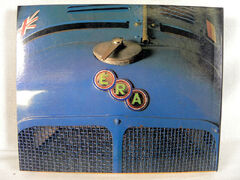
ERA badge on the front of the car.
ERA was founded by Humphrey Cook, Raymond Mays, and Peter Berthon in November 1933 in Bourne, Lincolnshire, near the family home of Raymond Mays. Their ambition was to manufacture and campaign a team of single seater racing cars capable of upholding British prestige in Continental Europe.
The car would have a modified Riley 6 cylinder engine with a bespoke supercharger and was capable of around 180-200BHP. The chasis was to be designed by Reid Railton, designer of the Bluebird and Railton Special land speed record cars and built a by Thomson & Taylor at Brooklands with new car’s single-seater bodywork was designed by Mr Piercy who had previously designed the bodywork for the Bluebird record breaker.
Prior to Formula One World Championship
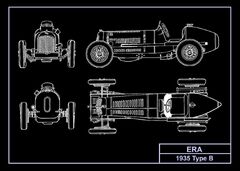
ERA B Type Blueprint
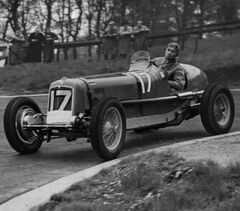
Bira loved his ERA
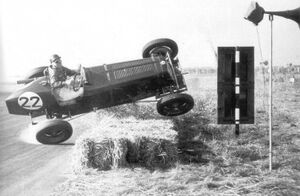
Privateer Geoffrey Ansell at Silverstone '48
The car was unveiled at Brooklands in May 1934 and after handling issues were resolved, ERA soon began to score victories in 1500cc races. A notable success was at the Nürburgring in 1935 where ERAs took first, third, fourth and fifth places.
ERA dominated 1500cc Motor Racing across the 1930's, with drivers of the calibre of Dick Seaman in the team and privateer cars driven and ran by the two Siamese Princes; Prince Chula and Prince Bira who would make the marque famous with their White Mouse Racing cars; Romulus and Remus.
The E-Type ERA appeared just before the Second World War but was not fully developed. By the time racing resumed in the late 1940s Berthon and Mays had moved on to British Racing Motors; BRM.
Leslie Johnson purchased ERA and built two E-Types known as GP1 and GP2. At the 1948 British Empire Trophy, Johnson in GP2, refitted with a Zoller supercharger set joint fastest lap on his way to 5th and at the 1948 British Grand Prix, after posting the fastest time in the opening practice session, Johnson retired GP2 from third place on lap 1.
Impressive speed and poor reliability continued, in practice for the Coupe du Salon at Montlhéry, Johnson broke the lap record but retired GP2 from the race after 3 laps with a fractured fuel tank and in Jersey the car did not race after the wheel bearings seized in practice.
Meanwhile GP1 had its share of troubles too; fuel starvation and defective steering in Jersey and gearbox, steering problems, a leaking radiator, and the exhaust burning the driver's foot at Goodwood.
Whilst privateers in older models such as Bob Gerard continued to get good results against newer machinery.
Formula One World Championship
1950
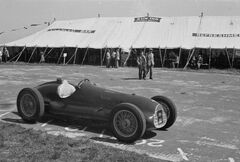
GP2 sits outside the Beer tent
There was four ERAs in the field for the season opening British Grand Prix, the home race for the marque. Leslie Johnson's works E-Type qualified in the middle of the pack, and became the first retirement in a Championship race when his supercharger disintegrated, causing a fire.
The fastest ERA in qualifying for that race was another E-Type, privately entered by Peter Walker. Walker qualified in the top ten, but suffered gearbox troubles in the race, handing over to Tony Rolt on lap 2. Rolt fared no better and retired the car soon after. Bob Gerard finished sixth in another privately entered car, his a B-Type, and repeated that result at the following Monaco Grand Prix, this time driving an A-Type.
Cuth Harrison drove his B-Type in three Grand Prixs in 1950. He finished a career best seventh behind Gerard at Silverstone, before falling victim to the pileup at the start of the Monaco Grand Prix. He was running in eighth at the season finale in Italy when he suffered a gearbox failure.
F1 Summary
| Year | Entrant | Chassis | Engine | Tyre | Driver | Rounds | Points | Position |
|---|---|---|---|---|---|---|---|---|
|
1950 |
ERA E | ERA L6 1.5L | D | 1 | 0 | N/A | ||
| 1 | ||||||||
| 1 | ||||||||
| ERA B | 1 | |||||||
| ERA A | 2 | |||||||
| ERA B | 1-2, 7 |
List of race wins
| Win Number | Event | Driver | Notes |
|---|
Statistics
Template:Statbox manual
